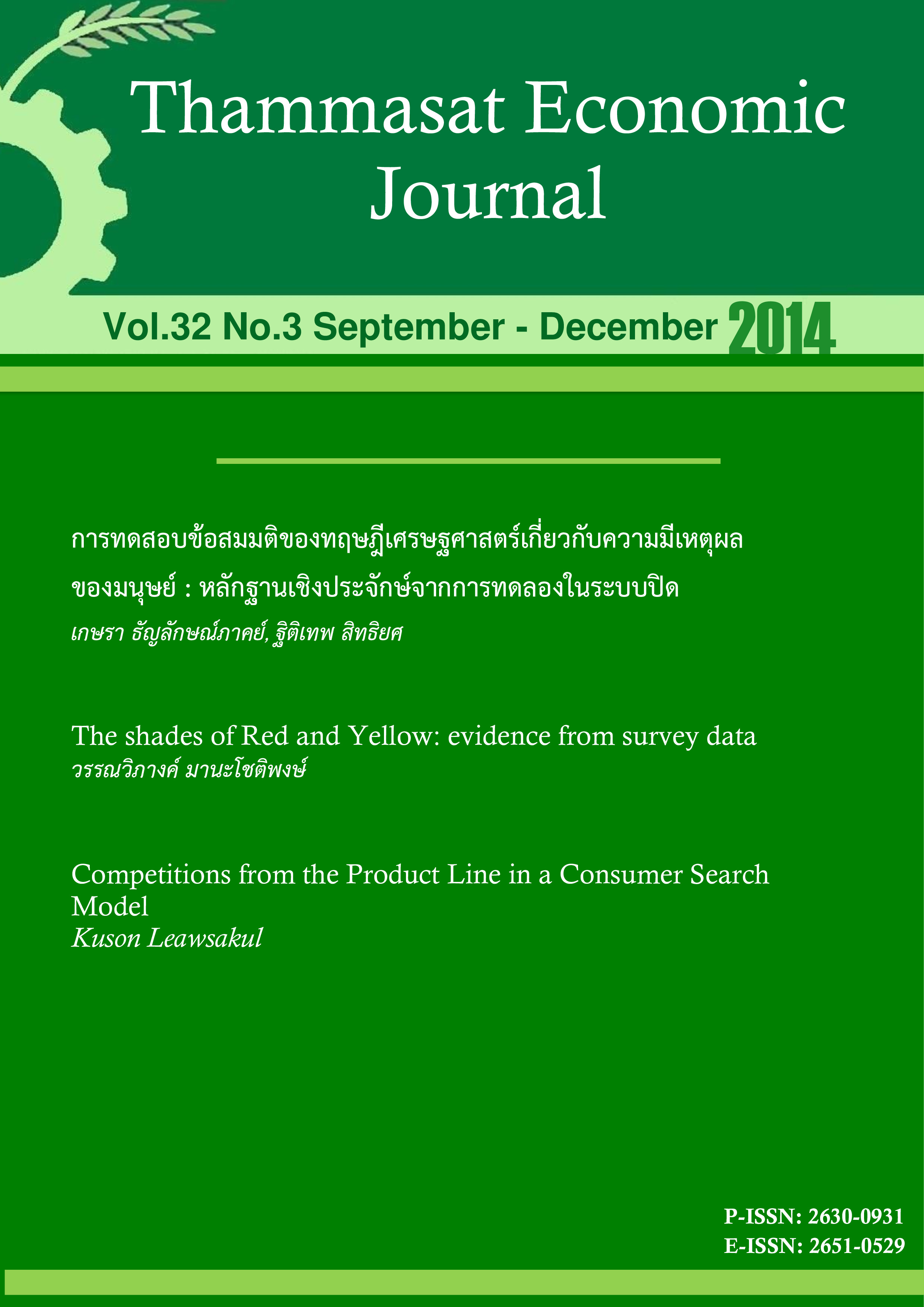Competitions from the Product Line in a Consumer Search Model
Abstract
This study aims to investigate the competitions from the product line when consumers search among two multiproduct firms for differentiated products. In the first model, a firm is created to be prominence that will be sampled first by all consumers. Firms compete in product line to insure certain utility to the consumers. Prominent firm earns higher profit, charges a lower price and provides longer product line. A counter intuitive result shows that the prominent firm’s product line increases with the search cost. This model does not support the role of product line to enhance pricing power.
The model is further modified that consumers freely choose which the firm they will visit first. The product line serves the second role to create firm’s saliency in consumer’s memory. The firm with lower production cost can raise attention more easily and extends longer product lines. This salient firm maintains higher profit, and charges a higher price compared with its less-salient rival. With harder search, consumers face more brands with higher prices. In the social welfare perspective, we find that all social optimal product lines and prices are lower than those determined to maximize profits. Since firms need to gain the attentions, they over invest in product lines.
References
2.Casella, G., Berger, R. L. (2002). Statistical Inference. Pacific Grove, California: Duxbury/Thomson Learning Inc.
3.Mas-Colell, A., Whinston, M. D., & Green, J. R. (1995). Microeconomics Theory. New York: Oxford University Press Inc.
4.Anderson, S. P., & Renault, R. (1999). Pricing, Product Diversity, and Search Costs: A Bertrand-Chamberlin-Diamond Model. RAND Journal of Economics, 30(4), 719-735.
5.Anderson, S. P., & Renault, R. (2009). Comparative Advertising: Disclosing Horizontal Match Information. RAND Journal of Economics, 40 (3), 558-581.
6.Armstrong, M., Vickers, J., & Zhou, J. (2009). Prominence and Consumer Search. RAND Journal of Economics, 40(2), 209-233.
7.Armstrong, M., & Zhou, J. (2011). Paying for Prominence. The Economic Journal, 121(556), 368-395.
8.Bagwell, K., & Ramey, G. (1994). Coordination economies, advertising, and search behavior in retail markets. The American Economic Review, 498-517.
9.Butters, G. R. (1977). Equilibrium Distributions of Sales and Advertising Prices. The Review of Economic Studies, 44(3), 465-491.
10.Cachon, G. P., Terwiesch, C., &Xu, Y. (2005). Retail Assortment Planning in the Presence of Consumer Search. Manufacturing & Service Operations Management, 7(4), 330-346.
11.Cachon, G. P., Terwiesch, C., & Xu, Y. (2008). On the Effects of Consumer Search and Firm Entry in a Multiproduct Competitive Market. Marketing Science, 27(3), 461-473.
12.Diamond, P. A. (1971). A Model of Price Adjustment. Journal of Economics Theory, 3, 156-168.
13.Draganska, M., & Jain, D. C. (2005). Product-Line Length as a Competitive Tool. Journal of Economics & Management Strategy, 14(1), 1-28.
14.Draganska, M., & Jain, D. C. (2006). Consumer Preferences and Product-Line Pricing Strategies: An Empirical Analysis. Marketing Science, 25(2), 164-174.
15.Grossman, G. M., & Shapiro, C. (1984). Informative Advertising with Differentiated Products. The Review of Economic Studies, 51(1), 63-81.
16.Haan, M. A., & Moraga-González, J. L. (2011). Advertising for Attention in a Consumer Search Model. The Economic Journal, 121(552), 552-579.
17.Rhodes, A. (2011). Can Prominence Matter even in an Almost Frictionless Market?.The Economic Journal, 121(556), 297-308.
18.Varian, H. R. (2007). Position auctions. International Journal of Industrial Organization, 25(6), 1163-1178.
19.Weitzman, M. L. (1979). Optimal Search for the Best Alternative. Econometrica, 47(3), 641-654.
20.Wolinsky, A. (1986). True Monopolistic Competition as a Result of Imperfect Information. The Quarterly Journal of Economics, 101(3), 493-511.










